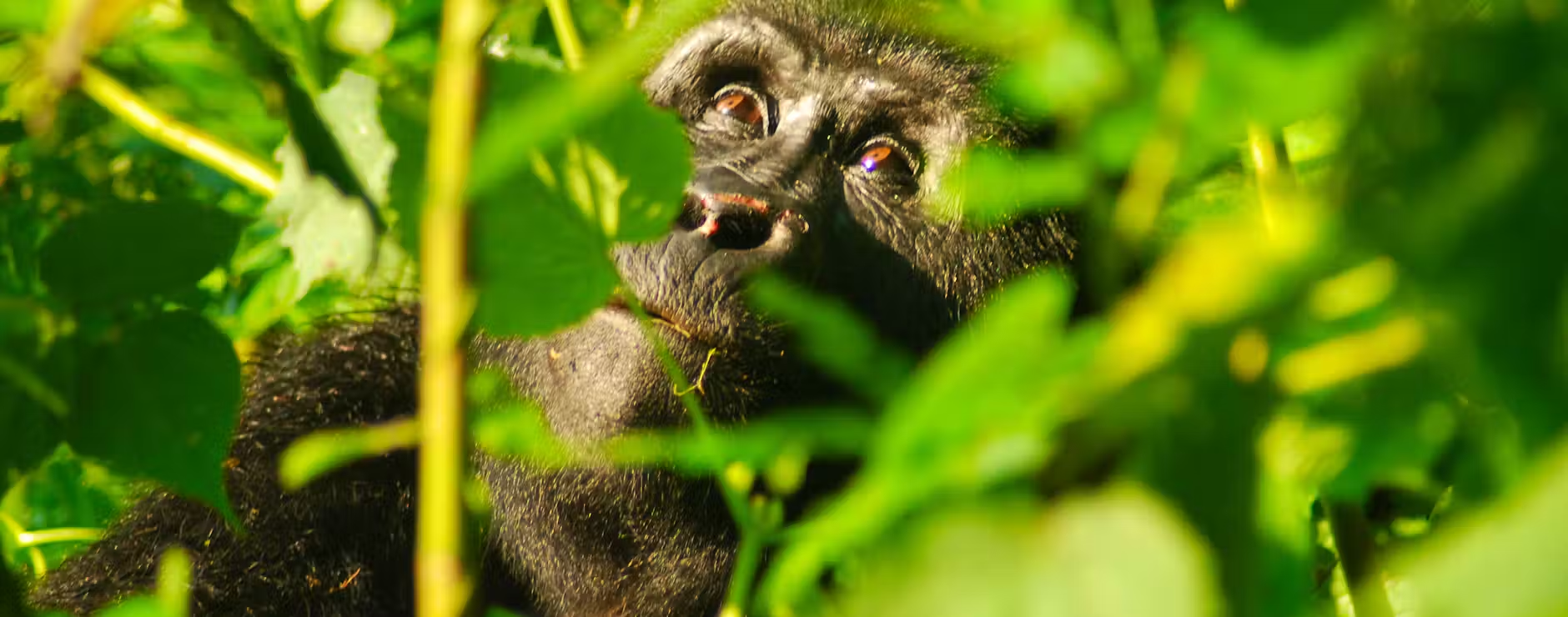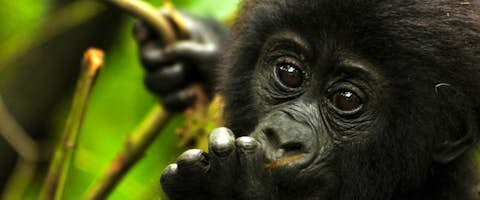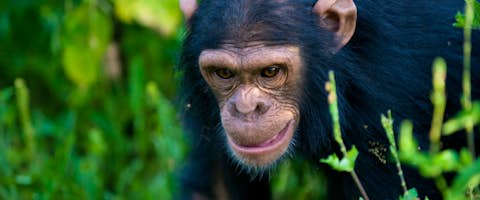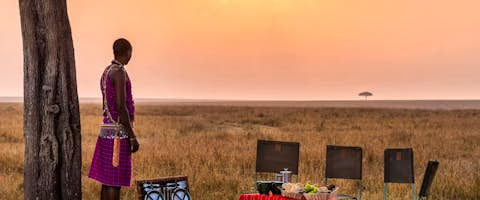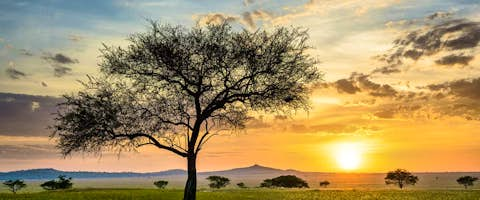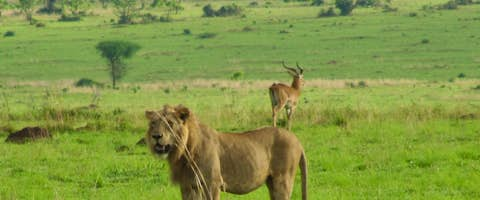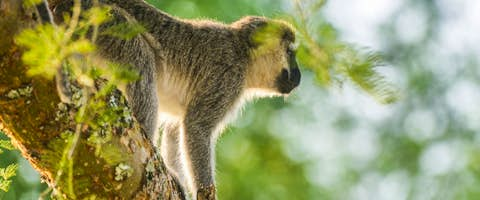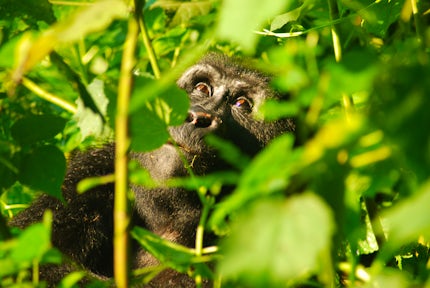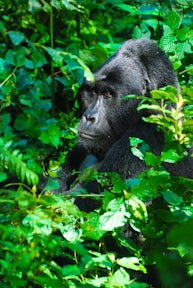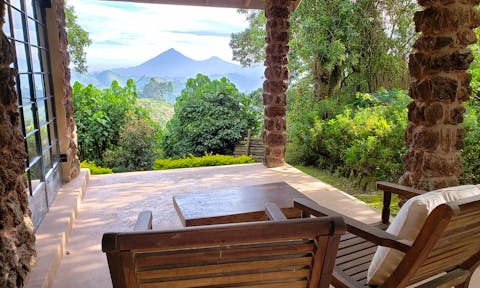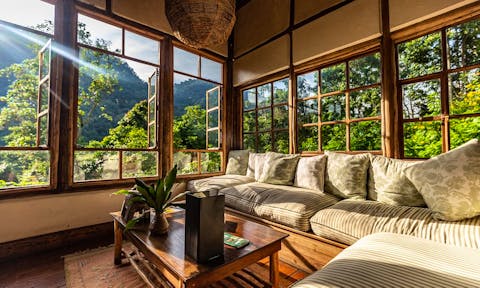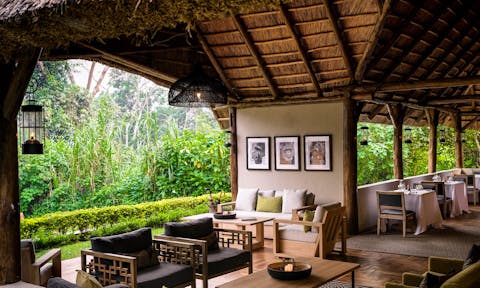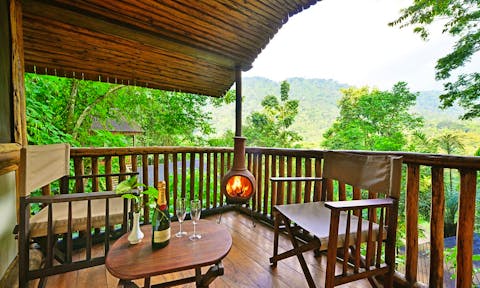Complete Guide to Gorilla Trekking in Uganda
Contents of our guide
- Popular trips & example itineraries
- Where can I track gorillas in Uganda?
- When is the best time to go?
- Securing a gorilla permit
- How difficult is the gorilla trekking?
- What to wear on a gorilla trek?
- The rules around gorilla trekking
- Are gorilla sightings guaranteed?
- What are the accommodation options?
- The Mountain Gorilla
Gorilla Fly-in Safaris
The tours below showcase just some of what is possible. Use these itineraries as starting points, or to draw inspiration. Then get in touch, and let our expert team help craft the perfect itinerary for you.
Multi-week adventures including gorilla trekking
Gorilla trekking can be done as a standalone adventure, but is usually combined with other safari experiences in the south-west. Below are some examples of what is possible. Our team can help you choose the trip that's right for you, or build a tailor-made itinerary to get the most out of your time in the country.
1. Where can I trek gorillas in Uganda?
There are two gorilla trekking destinations in Uganda: Bwindi Impenetrable National Park and Mgahinga Gorilla National Park.
Bwindi is by far the more popular choice as the park contains a greater population of gorillas, is better situated for fly-in safaris, and has a greater range of accommodation options.
Which park you visit will depend on your wider travel plans and the time you have available. There is no difference in permit prices or chances of sightings across the two parks.
As you'll notice from the map on the left, both Bwindi and Mgahinga are in the deep southwestern pocket of Uganda, near the border with Rwanda to the south and the DRC to the west.
Many of Uganda's safari destinations are also found in the south-west. This makes it easy to combine a savannah safari with gorilla trekking to create a single itinerary bursting with once-in-a-lifetime experiences.
Uganda may be a small country, but it packs a punch.

Gorilla Trekking in Bwindi Impenetrable National Park
Bwindi is Uganda's main gorilla trekking destination. Here, habituated families can be accessed from four trail heads: Buhoma, Ruhija, Rushaga and Nkuringo.
Each trail head has its own characteristics, families and levels of difficulty.
Departing from one of the four trailheads on the perimeters of the forest, you join a group of other trekkers (maximum group size of 8 people) for a guided hike into the forest in search of one of the 11 habituated gorilla families.
Led by experienced Uganda Wildlife Authority guides, you will be introduced to the ecology of the forest and the changing landscape as you trek to the gorillas. Your guides are in communication with the team of trackers who will have been shadowing the gorillas since daybreak. The trackers direct your guides to bring you to the gorillas.
The Gorilla Treks
Two tours run daily from the base camp, usually starting at 09:00 or 14:15 and are limited to groups of eight.
The limit on group size is to keep to gorillas safe from any airborne pathogens, but also to increase the chances of sightings, as larger groups often scare off these (surprisingly) timid animals.
From the onset, the imposing southwestern sloped hills and terraced volcanoes prove a formidable adversary. This is gorilla territory, and access requires hiking through the thick, triffid-like tangles of vegetation, up muddy hills and down into craggy valleys.
The high altitude and testing terrain make the journey tiresome, but the rewards all the more magical.

Gorilla trekking is hard work, but the rewards are immense.
Making Contact
Once contact is made, there is usually a silent wait, deep within the dense foliage, as the gorilla’s edge closer.
When they do emerge, seeing the gorillas in their natural habitat, the verdant forest providing the perfect backdrop, is a truly breathtaking experience.
Any silence is soon broken by the rustling of leaves as the gorillas wander and play, and the calls, whistles, and whoops of thousands of animal species for miles around provides the perfect sound-track.
Once contact is made, you have up to one hour to spend with the gorillas. If you wanted to spend longer, you can take part in a gorilla habituation experience, and spend up to 4 hours with these gentle giants.
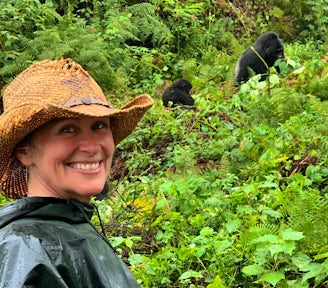

Brilliant says
It's not hyperbolic to say that gorilla trekking is Africa's most extraordinary wildlife experience. The trekking team are absolute professionals, and the beautiful lodges nestled around the national park mean you can fully embrace the 'hard days, soft nights' travel philosophy.
The 4 Trailheads
Habituated families can be accessed from four trail heads: Buhoma, Ruhija, Rushaga and Nkuringo. Each trail head has its own characteristics, families and levels of difficulty.
The trailheads serve as launch points for treks to 11 fully habituated (and three semi-habituated) gorilla family groups. The standard treks depart in the morning and include up to one hour observing the gorillas from a distance of about seven metres.
The treks can be quite challenging, and you need to be prepared to trek for up to 6 hours, although most sightings take place within 2-3 hours.
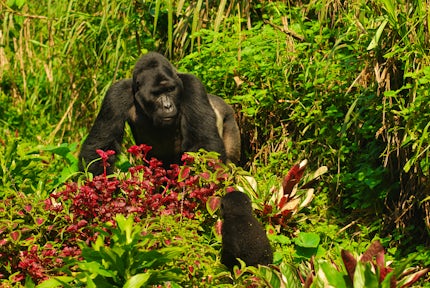
Mother keeping watchful eye on her young.
Gorilla Trekking in Mgahinga
Close to the border with Rwanda, Mgahinga National Park is a popular option for cross-over itineraries with Rwanda's Volcanoes National Park. It's also the only place in Uganda where you can trek Golden Monkeys. A popular option is to combine gorilla trekking in Nkuringo (Bwindi) with a gorilla trek at Mgahinga.
Mgahinga is more secluded than Bwindi and the treks are not as challenging. There are fewer permits available here. Although gorilla families constantly cross the border from Rwanda to Uganda, there is only one family habituated to make contact in Mgahinga. Called the Nyakagazi group, it has five silverbacks, two adult females and three young gorillas.
Traditionally, Mgahinga was used as an ‘over-flow’ gorilla trekking destination for Bwindi, but that has changed for two reasons. The first is that the increase in the cost of Rwandan gorilla permits to $1,500 per person has prompted visitors to explore Rwanda and then nip across the border to Mgahinga where the treks cost $700 per person.
The second reason is that Mgahinga is such a wonderful place to visit. Situated so closely to the lakes Mutanda and Bunyoni, you could spend a week in the far south-west and save the rest of Uganda for a second trip!
You can also climb the volcanoes at Mgahinga - all pretty intense hikes surpassing 4,000 metres with 8-9 hours hiking, but a very rewarding adventure.
Mgahinga accounts for around 10% of all gorilla treks in Uganda, the vast majority are done at Bwindi!

Afternoon walk around Lake Mutanda
2. When is the best time to go?
Uganda's equatorial climate means temperatures remain quite consistent year-round. Rainfall is all that separates the seasons. March to May is the long rainy season, and October to November is the short rainy season.
The gorillas can be visited at any time of year.
The price for the gorilla permits used to change with the season, but this is unfortunately no longer the case. Permit prices are fixed year-round, so the decision on when to visit should be guided by your availability, the availability of permits, and your travel plans outside the gorilla trekking.
3. Securing a Gorilla Permit
Gorilla permits are currently fixed at $700 USD per person.
The permits are no longer discounted during the rainy season, but they are easier to secure at short notice if you are travelling during Uganda's long rainy season (March to May) or in the short rainy season (October to November).
For peak travel months (January - February and June - August), permits can sell out as early as a year in advance. The permit numbers are strictly limited, so we strongly recommend planning early.
One advantage of visiting the gorillas in Uganda is the relatively cheap permit costs compared to neighbouring Rwanda where permit prices sit at an eye-watering $1500 USD per person at time of writing.
If one hour of contact is just not enough, if you are a wildlife photographer, or if you are simply fascinated by the behaviour of these incredible animals, then it is also possible to join the habituation team in the Rushaga section of southern Bwindi. This experience includes up to four hours with the family, observing the individuals and their interactions, and costs $1,500 per person.
Gorilla permits are non-refundable, but if you trek and do not see a gorilla, the Uganda Wildlife Authority will refund 50% of the permit cost. This happens very rarely.
4. How difficult is the trek itself?
You should be prepared to walk through a challenging terrain of steep ridges and valleys, following animal paths through tangled undergrowth for about 3 hours, although sometimes contact can be made after 45 minutes, and other times 6 hours.
During the rainy season, the trekking routes can become very slippery and much more challenging. The rains can sometimes bring the gorillas to lower ground which can shorten the length of the trek, but you should be prepared to trek for up to 6 hours in any case.
The gorillas typically prefer the highlands, so the trek is made more challenging due to periods of steep gradients.

5. What to wear on a gorilla trek?
Charging through the dense forest thickets at both Bwindi or Mgahinga require a well-considered get-up. Since you're on the equator, you will need to be prepared for rains no matter what time of year you are travelling. While you want clothing that protects you from the elements, you also need to keep cool for the 2-6 hour trekking, so you'll want light and comfortable clothing.
The name of the game is keeping your skin covered up to protect yourself from the forest critters (particularly fire ants) and thorny plant life. You'll want to keep dry whilst also staying comfortable and cool.
The essential clothing:
- Good quality, robust, waterproof trekking shoes/boots.
- Light waterproof trekking pants/trousers.
- Long socks to pull up over your pants/trousers to keep your skin protected. Waterproof Gaters are an even better option.
- Waterproof jacket/rain coat/wind breaker
- Long sleeve trekking T-shirt (ideally Dri-FIT or similar)
- Gardening/outdoor gloves to protect against thorns and allow you to push through the more difficult parts of the trail without worrying about what you're grabbing on to!
We also recommend bringing a few sachets of re-hydration salts. Water is of course provided for the treks, but you can often find yourself dehydrated after a full day of trekking and the salts can provide quick relief.
Walking sticks are provided for you.

6. The rules around gorilla trekking
Before you start any gorilla trek, you will be given a brief from your guide about the rules to follow throughout your time tracking the gorillas. It is extremely important you listen closely to this briefing and respect the rules laid out.
The headlines are:
- You will be given 1 hour to spend with the gorillas once first contact has been made. This may not seem like a long period of time, but most people find that one hour is more than enough time to soak up the experience. If you want a lengthier experience, you can join the gorilla habituation team and spend up to 4 hours with the gorillas. Another popular option is to do 2 gorilla treks in different areas of the park. Enquire for details.
- You must keep a distance of at least 7 metres at all time.
- No flash photography under any circumstances.
- You cannot join the gorilla trek if you find yourself unwell prior to the trek.

The Gorillas roam in small familial groups.
7. Are Gorilla sightings guaranteed?
While we can never guarantee sightings, the rise of the gorilla populations in Uganda combined with the experience of your trekking guide means that encounters are almost always made in Bwindi or Mgahinga.
That said, you have to be prepared to work for it as you might have to trek for 6 hours before finding a habituated group.
If you do end up not seeing the gorillas, the Uganda Wildlife Authority will refund 50% of your permit cost. In all of our years of working in Uganda, we've never had anyone not see the gorillas.

Gorillas are found deep within the thickets of Bwindi.
8. What are the accommodation options?
Accommodation in Bwindi Impenetrable National Park
The majority of the lodges around Bwindi are found in the region Buhoma. From your base at Buhoma, you can trek both the Buhoma routes and the Ruhija routes.
Over the years, simpler places like Engagi Lodge and Haven Lodge have developed loyal followings. In the mid-range Mahogany Springs and Buhoma Lodge are reliable favourites, while Gorilla Forest Camp and Bwindi Volcanoes Lodge are two of the best options available.
Properties in Ruhija and Rushaga are available, but are used less often. While they are closer to the trail heads, feedback on the quality of accommodation and service is often mixed.
In the far south, the beautiful Clouds Mountain Gorilla Lodge provides stylish, luxury accommodation, with Nkuringo Lodge providing a slightly simpler, but swiftly improving, alternative.
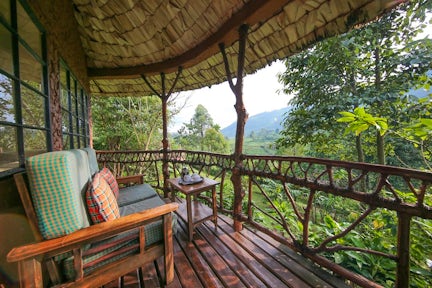
Accommodation in Mgahinga Gorilla National Park
There is only one tourist lodge currently available in Mgahinga, the luxurious Mount Gahinga Lodge.
Sister property to Volcanoes Bwindi and Kyambura Gorge, the lodge is a stylish and comfortable options located just a few hundred metres from the park gate. Lovely gardens brings the wildlife to your door.
The lodge has also done incredible work supporting the local Batwa community evicted from the forests when the park was gazetted. They have built a village, established a cultural centre, helped run a dance group - with the aim of aiding the integration of the Batwa with the other local communities - and begun a vocational training centre.
Further afield, Mgahinga is accessible from lodges on Lake Mutanda like Chameleon Hill and on Lake Bunyonyi like Birds Nest.
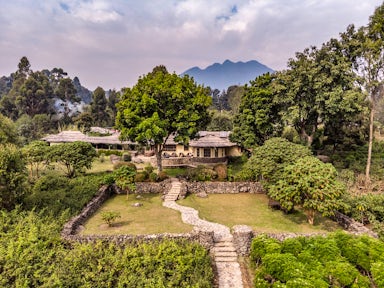
The landscapes inspire the design of many Ugandan lodges.
9. The Mountain Gorilla in Uganda
In 1903, on the slopes of Mt Sabyinyo in what is now Rwanda, German army officer Captain Friedrich Robert von Beringe shot two gorillas, thereby introducing zoologists to the Mountain Gorilla.
Today, a small but stable population exists, split between the Virunga Volcanoes of the DRC and Rwanda and the forests of southwestern Uganda.
The mountain gorilla is a very large, very black, barrel-chested ape, densely-furred (to protect against the cold) with a broad face. They are found in mountain and sub-alpine environments, enjoying dense tangles of herbaceous growth in valley bottoms, old clearings and around landslides.
The restricted environment means that the mountain gorilla has a more restricted diet than its lowland counterpart, feeding mainly on bamboo, but also the leaves, shoots and stems of over 140 other species, plus vines and wild celery.
They are highly sociable and exist in groups of between 5 and 50 individuals. The group will have one dominant ‘silverback’, an adult male above the age of 13 (when silver hairs begin to grow in the saddle of the back), sometimes assisted by subordinate silverbacks. The silverback eats first, but is also responsible for the defence of the group, a trait that enables gorillas to spend more time on the ground than the other great apes. When the silverback dies, his group will split.
Groups forage throughout their home range, but do not defend it. When two groups move close to one another, they will avoid contact in order to reduce the risk of conflict. They spend much of the day resting, which provides such a great opportunity for trackers to join and observe the group.
Reproduction occurs slowly, with adult females over the age of eight producing on average one young every four years and often no more than six in a lifetime. The young have an extended childhood and are carefully cared for and fiercely protected by both the females and the dominant silverback. If a silverback dies or is pushed from the group, then the incoming dominant male will often kill any young gorillas, which means that a dominant silverback is always protected by the females when threatened.
The protection and slow population growth of the Gorillas can be credited in no small part to the travellers who come to visit them. Without this crucial finance, the incentives to protect the gorillas' environment would be drastically reduced, and we might not have any gorillas left in their natural habitats today.

Brilliant says
Coming face to face with mountain gorillas in their natural habitat is one of the most powerful and humbling wildlife encounters possible. You can always spot trekkers who are returning from having been with the gorillas: even the strong and silent types are grinning and chattering like birds.
Brilliant Africa - 2024 Season
3 reasons to book with Brilliant
1. Highest-rated safari company on Trustpilot
So you can book with confidence knowing you're in safe hands.
2. A fully bespoke service and expert impartial advice
Planning a trip to East Africa is complicated. Brilliant makes it easy. Our team have spent decades in the region so we can help you find the right trip - and we don't charge a fee.
3. Exclusive access at the best rates
We have exclusive access to the best value-for-money camps and lodges at rates you won't get anywhere else.

Meet the Mountain Gorillas
Gorilla trekking can be done as a standalone adventure, but is usually combined with other safari experiences in the southwest. Below are some examples of what is possible. Our team can help you choose the trip that's right for you, or build a tailor-made itinerary to get the most out of your time in the country.
Travel with Brilliant Africa
Every year, we help hundreds of travellers explore East Africa.
Our team can help you find the trip to match your dreams, budget, and appetite for adventure.
Ready to plan your African adventure?
Listen
We'll spend some time listening to your aspirations, then discuss the kind of experience that might suit you.
Match
Next we'll discuss the options, shortlist the best trips for you and present you our impartial recommendations.
Reserve
We'll place a 24 hour hold on your preferred option - without obligation - whilst we talk through the details.
Whatever your budget, group size, length of stay, preferred activity or appetite for adventure, we can help.
+1 315 645 2889

